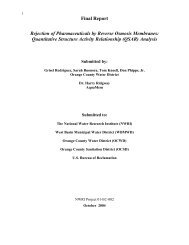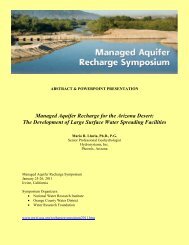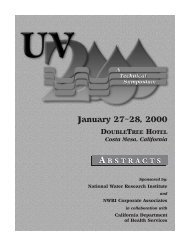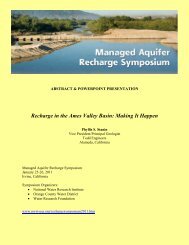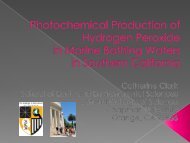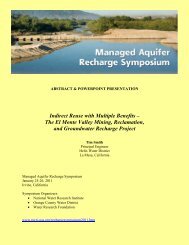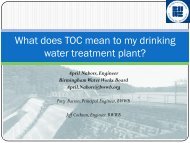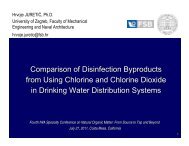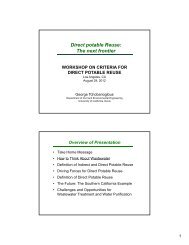RBF_Cover (for eps) - National Water Research Institute
RBF_Cover (for eps) - National Water Research Institute
RBF_Cover (for eps) - National Water Research Institute
Create successful ePaper yourself
Turn your PDF publications into a flip-book with our unique Google optimized e-Paper software.
66<br />
Table 1. Effect of Control Measures on Raw-<strong>Water</strong> Quality at the <strong>RBF</strong> Site in Torgau<br />
(Grischek, 2002)<br />
Control Measure Bank- Effect on Raw-<strong>Water</strong> Quality<br />
Filtrate DOC Trace NO3 – Fe 2+ NH4 + SO4 2–<br />
Portion<br />
Organics Mn 2+<br />
Continuous operation of wells<br />
with increased abstraction rate<br />
Continuous operation of wells<br />
with decreased abstraction rate<br />
Periodic operation of selected wells<br />
Preferential operation of selected<br />
wells with favorable catchment area<br />
Operation of every second or third<br />
well within a group of wells<br />
Technical measure<br />
Change of the well filter depth<br />
➚<br />
➚<br />
➚<br />
➚<br />
— — —<br />
➚<br />
➚ ➚➚➚<br />
➚ ➚ ➚<br />
➚<br />
➚<br />
➚➚➚<br />
➚<br />
— — — — —<br />
— Effect is negligible or only temporary. Concentration increase. Concentration decrease.<br />
—<br />
Readily degradable and highly adsorbable organic compounds are attenuated in the biologically<br />
active riverbed. Long flow paths and long retention times of the bank filtrate in the aquifer allow<br />
further attenuation of poorly degradable and some polar organics.<br />
A field test was done to study the effect of an increase in water abstraction resulting in a decrease<br />
in retention time of bank filtrate in the aquifer. Over a period of 1.5 years, water abstraction from<br />
five selected wells was increased by about 40 percent. Excluding some slight changes in water<br />
quality near the bank line, no significant effect due to the decrease in retention time was observed.<br />
DOC removal and denitrification along the whole flowpath were not affected (Grischek, 2002).<br />
A continuous operation of selected wells has the advantage of lower concentrations of dissolved<br />
iron in raw water. High concentrations of dissolved iron were not measured in the bank filtrate,<br />
but were measured in the landside groundwater. Switching off the abstraction wells results in<br />
groundwater flow towards the river and the transport of dissolved iron into the aquifer zone<br />
between the wells and river. When the pumps are switched on again, higher iron concentrations<br />
are observed in raw water. Furthermore, periodic well operation leads to higher well clogging.<br />
A groundwater flow and transport model has been used to simulate the change of the well filter<br />
depth and its effect on groundwater flow, especially groundwater flow from the opposite side of the<br />
river beneath the riverbed to the wells. Due to the long distance between the wells and bank line,<br />
the effect was found to be negligible. A change in the filter depth should only be considered if the<br />
aquifer consists of layers with very different hydraulic conductivities and if the well is located at a<br />
short distance from the riverbank (the distance is less than aquifer thickness).<br />
Surprisingly, the most important factor was the selection of abstraction wells according to their<br />
catchment zone <strong>for</strong> landside groundwater. Based on the dense net of observation wells, it was possible<br />
to identify zones with different concentrations of DOC and dissolved iron in landside groundwater.<br />
Figure 1 shows the range of DOC concentrations in groundwater in the catchment zones behind<br />
the wells.<br />
—<br />
—<br />
—<br />
—<br />
➚<br />
—<br />
➚ ➚➚<br />
➚ ➚<br />
➚<br />
➚<br />
➚ ➚➚➚



